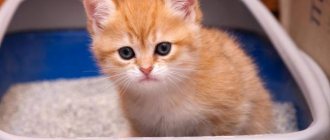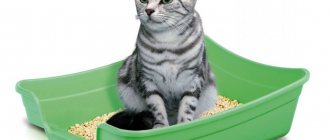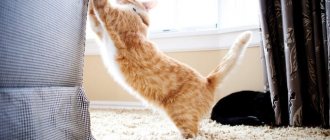The process of litter box training can be quite slow, and you need to be mentally prepared for this. Once in a new home, the pet will experience stress from the change of environment. Before he engages in the training process, he must calm down.
For an adult cat that has already been trained to use the litter box, a change of residence is unlikely to interfere with the ability to navigate the new environment and begin using the toilet correctly. The situation will be much more complicated if a pet from a shelter or from the street appears in the house. Owners need to prepare themselves in advance for the hard work ahead.
At what age does training begin?
The right recommendations will help speed up the long process. Kittens are also children, so there is no certain age for litter box training to be easy and quick. You can force an animal to go potty at 2 months or after three - it depends on its intelligence and learning ability.
If a baby lives with a mother cat, he copies her behavior. The two-month-old kitten is already coping with the task on his own. If the mother is not nearby, the owner can train the cat to use the litter box.
It is not difficult to train a kitten to use the toilet in an apartment, especially when there is a cat nearby, even at 1 month, if the pet is smart. It’s not too late to do this even at 3 months.
conclusions
If the proposed methods do not help, then the cat should be limited in its freedom of foresight around the apartment, leaving it a small area where the tray will stand. Everyone knows that cats are clean creatures, so after a while your pet will understand what the tray is for, and the problem will be solved. There are cases when a cat that has already been trained to use the litter box suddenly begins to relieve itself in the wrong places. There is no point in scolding and beating her for this. You just need to reconsider your relationship with her or contact a veterinarian. The cat may simply lack attention, or such chaotic bowel movements may be a symptom of some disease. These very simple recommendations can help you cope with the problem of “cat litter”. You just need to be persistent and patient at this time. Then your pet will learn to be well-mannered, and in return you will receive a lot of pleasure and joy when communicating with him.
Video
Choosing a litter box for a kitten
An incorrectly selected tray is one of the first factors that will prevent you from teaching a small kitten to order. Below we consider the types of devices:
- open without mesh;
- open with mesh;
- tray-house;
- self-cleaning.
The correct tray for a cat is wide and with high sides. This is a general requirement for each type.
Open without mesh
A tray without a mesh will not have to be washed every day, and the animal will not injure its paws while trying to dig. But not every type of litter is suitable for it: the cat will carry it around the apartment and scatter it around the tray.
Open with mesh
More complex design. A net is installed on the container where the animal sits. Costs more, but is more hygienic. You can put any filler into the tray; it is inaccessible to the cat.
There are disadvantages:
- The mesh needs to be washed daily.
- The baby will still scratch the surface and may injure his paws.
The main disadvantage of both types of trays is their openness, which makes it more difficult to train a kitten to go to the toilet.
Tray house
An excellent choice for a small living space. It can be placed in the bathroom or hallway. It’s not difficult to make it yourself: the main thing is not to forget about the removable lid to make it convenient to clean. With or without mesh – the owner’s choice.
Important: You can buy an ordinary tray and make a tall, lightweight lid yourself.
Self-cleaning
Premium category trays. Almost no owner intervention is required. Simple models are equipped with a rake for leveling the filler and removing used lumps, a carbon filter to eliminate odors, and a silent motor with which this design operates.
The most expensive models require a constant connection to the network and sewerage.
Selecting a tray by size
So, how to train a kitten to go to the litter box. First you need to purchase everything you need for this:
- Tray.
- Filler.
First of all, you should choose a suitable container . Of course, a kitten can easily fit into even the smallest one. However, do not forget that the animal grows quickly and the container will have to be changed soon. The cat will have to get used to the new litter box again. In other words, the animal will have to be retrained.
High side
A kitten can, if desired, fit into an almost large tray, but only if its sides are low. Such containers are not always suitable for cat litter. Therefore, it is worth purchasing a container with high walls. So that the kitten can easily fit into such a toilet, you can make a simple device for this. It is enough to cut a small strip of plywood and attach it to one of the edges of the tray at an angle. The animal will climb into the tray along it.
If desired, the bar can be made from another material. The main thing is that it is non-slip. It is best to attach the bar with tape. In the future, it can be removed without damaging the container.
Is it worth buying a closed tray?
Since training a cat to use a litter tray is not particularly difficult, several rules should be followed .
The first states that the container that serves as a toilet for the animal must be comfortable. It's no secret that cats love confined spaces. They feel more comfortable in them. An indoor cat toilet looks like a house. The main advantage of such a container is that odors will not spread throughout the room. In addition, many cats like to bury feces. In the process, they may end up scattering litter all over the room. A closed tray avoids this.
It is worth noting that the closed tray must be large. The animal should turn easily in it. Many cats do not immediately get used to such a toilet. Therefore, first you can remove the door. It will be possible to return it to its place after the animal gets used to it.
Filler selection
The filler is selected under the tray.
Important: cats do not like scented toilet granules, so using them will not give the desired results.
clumping
Available with or without flavoring. The clumping product is hygienic and easily absorbs moisture and unpleasant odors. The main rule of any litter: the smaller the kitten, the smaller the granules.
Zeolite
Zeolite filler is more expensive than wood filler, but is consumed more economically and absorbs moisture better. It does not stick to the kitten’s paws or fur if a special mat is placed under the tray.
Woody
Cats can taste the litter. The safest option in this case is wood. But without a special rug, the kitten will carry it around the apartment on its paws.
Grain and pulp
Both types are environmentally friendly, relatively inexpensive and made from organic substances. If the kitten accidentally swallows particles of the filler, it’s not scary. Grain and pulp products clump easily.
Silica gel (hazardous to animals if eaten)
One of the most expensive types. This is a substance that is placed in boxes with shoes and bags to absorb moisture and odors. The silica gel filler does not stick to the kitten's fur and paws and does not create a stench, but if there is too much water in the tray, a puddle may form.
It is best to place this litter under the net so that the kitten does not accidentally eat it.
No filler
Need a self-cleaning tray. There is no point in giving up filler in a conventional device. All problems can be solved in other ways:
- spreads on the paws - buy a special mat, then all the granules will remain on it;
- refuses to use - most likely, the kitten does not like litter with a smell or too hard granules;
- better than newspapers - printing houses use toxic ink, the fumes of which are dangerous;
- expensive - the cheapest filler is wood.
Create ideal conditions
In order for the kitten to quickly get used to its new toilet, it is necessary to clean it thoroughly .
This should be done as often as possible. A dirty litter tray is unlikely to attract an animal. The kitten will look for a cleaner place. If you use clumping litter, the used composition should be removed with a spatula and thrown into a bag. It's better to tie it right away. In the first weeks, you can leave feces in the cat's litter box. This will speed up the addiction process.
All filler in the tray must be changed regularly . This should be done at least once a week. In this case, the cat litter box must be washed thoroughly. You should not use toxic detergents. It is enough to use a soap solution. The tray must be dried after cleaning and washing. Only after this can it be filled with fresh product.
If the kitten has gone past the litter box, then this area must be carefully treated to eliminate odors. Otherwise, the incident will repeat.
The process of training a kitten to the tray
Be patient to finish what you start.
Important: Light massage stimulates digestion and the bowel movement reflex; When you sit the kitten on the potty, you can stroke its tummy.
Stage one - getting to know each other
For the first time, they put the kitten in the tray several times, take his paw and help him “dig.” Let the baby not be afraid to sniff the pot and the filler: this way he will get used to the place.
Stage two - observation and assistance
It is possible that you will have to run after the kitten throughout the apartment and watch when it starts meowing loudly, squatting, spinning in one place and scratching its paw on the floor.
Then you need to immediately carry him to the tray and not let him go until he goes to the toilet.
It will not be possible to correct the situation in 1 day, but if everything is done correctly, the cat will definitely get used to it.
Stage three - strengthening the reflex
Now the kitten can be scolded for ignoring the toilet. But not too much. When cleaning up after your baby, you just need to throw everything in the litter tray and take the kitten there when he starts looking for a place to go to the toilet. This must be done without shouting.
Additional tips and tricks
- You cannot hit a kitten or poke its face into the dirt;
- the optimal layer of filler in the tray is 5 cm;
- if the breeder’s baby was constantly lying on moisture-absorbing diapers, you will have to be patient;
- The kitten should also be praised for small progress.
Common Mistakes
- Wrong size of granules: the smaller the kitten, the smaller they should be;
- too early or late litter box training;
- If the baby relieves himself on soft surfaces, you need to put a piece of cloth in the filler.
Is it possible to train an adult cat to use a litter box?
It is more difficult to toilet train adult cats if they previously went about their needs on the street or in any convenient place in the house. But of course there are chances for success.
How to toilet train an adult cat:
- Close all hard-to-reach corners in the house: the area under the sofa, behind the closet, behind the refrigerator, etc.
- Choose a comfortable litter tray that matches your cat's size.
- If the animal has previously gone to the toilet outside, purchase a special litter that imitates the natural composition of the soil.
- Place the tray in an accessible place for your pet. The best option is in the toilet room. But do not forget to leave the door ajar so that the cat can visit the bathroom at any time without the help of the owner.
- During the first days of living in the house, observe the cat’s behavior. When she wants to go to the toilet, she will become restless and puzzled. The cat will look for a secluded place. Place her in a tray and lock her in the toilet for a while, leaving her alone. Cats don't like to be watched at this moment.
- If your cat goes to the litter box, be sure to praise her. You can even reward them with a tasty treat.
- If the first attempt is unsuccessful and the cat goes elsewhere, do not scold it. Collect feces in a napkin and place it in the tray for a while. If the cat urinated, pour sand over the urine, collect it, and do the same thing - put the collected feces in the cat litter box. Next time, the animal will be able to determine by smell the place where it needs to relieve its natural needs.
- If the cat shows persistence and basically goes to the toilet in the wrong place, move the tray there. As soon as he gets used to his new toilet, move the accessory to the bathroom.
If an adult cat categorically refuses to go to the litter box, try training her using special sprays.
Possible difficulties
If all the recommendations are followed, and the kitten does not go to the litter box, do not despair.
Pet doesn't go into litter box
You need to buy a device that is larger, wider, with higher sides, and it will become easier to teach your cat to go to the litter box.
Pet ignores litter box
If the baby goes to the toilet everywhere, check that the rules for choosing the device, filler and place for the tray are followed. If an already accustomed kitten is mischievous, the advice is the same:
- the tray should be without traumatic elements, preferably without a mesh;
- filler - odorless;
- put it in a dark, secluded place so that the animal is not afraid of anyone.
If the recommendations are taken into account, the pet will be able to go to the toilet where it needs to be. The exception would be a kitten that is too small. A one-month-old baby will not understand what they want from him.
Method No. 2 – Duplicate tray
This method is my invention. After suffering with the cat for a couple of months, I moved her litter box directly to the toilet, where it was intended to be, according to my plans. And in place of the tray under the sink I put an ordinary large herring tin with a newspaper inside. The can perfectly covered the most attractive place, in the cat’s opinion, and was also securely blocked by the cans standing there, so it was not easy to move it. Now my stubborn girl had a choice of two options: a comfortable, tested tray in a new place - in the toilet, and a small, inconvenient jar, but in a familiar place under the sink.
The choice of cat was obvious. Having broken down a little for the sake of decency, she went straight to her destination. A nuance: the jar stood under the sink until we moved, otherwise the favorite place was immediately used by the cat, just like in the good old days.
By the way, the problem didn’t even arise at the new place of residence. The cat immediately went to her litter box where it was placed and shown to her.
Is it possible to train a baby to use the toilet of another cat?
Smell is the main safety criterion for cats. The kitten will not use someone else's potty. In this case, even neutral flavors will not help accustom the cat to the litter box.
In order for the baby to learn to use a device that has already been used, the tray must be disinfected and make sure that foreign odors have disappeared.
Necessary purchases
An adult pet who has not previously been potty trained should also like the design of the new toilet. The tray should not only be spacious (suitable in size for certain animal sizes), but also comfortable.
There are two main types:
- closed structures;
- open trays.
Closed structures are an isolated structure (most often in the form of a house with a door or window), with special filters installed in it to retain unpleasant odors. Such modern trays are very convenient and attractive. An adult cat carries out all delicate procedures without any problems, hiding from strangers . This design can be placed not only in the bathroom, but also in the corridor, there will be no smells or inconveniences.
The disadvantages of closed devices include the high cost of the products, as well as the difficulty of training adult street pets.
Freedom-loving pets who previously relieved themselves in nature are unlikely to agree to the small confined space of a new tray. Closed litter boxes for cats are quite difficult to clean, because the entire structure will have to be disassembled and reassembled. If the animal has health problems, this procedure will have to be carried out regularly, several times a day.
It is much easier to train your cat to use an open litter box. Wide and comfortable deep designs greatly simplify the training process . There are high-sided litter boxes that allow your pet to bury their waste, and low-sided litter boxes that are better suited for smaller cats and kittens. Also, open trays come with or without bars.
When arranging a cat litter box, the choice of litter is of great importance. This is a real find for those pet owners who are away from home most of the day. The structure of the filler allows all liquid to be absorbed, reliably locking in all odors. The lack of filler is unhygienic and inconvenient . In addition, it is much more difficult to train a cat to use the toilet in an empty tray. Clean animals often refuse to go to the right place if the potty is not cleaned.
© shutterstock
There are several main types of fillers:
- woody;
- silica gel,
- mineral,
- filler from industrial waste.
For adult cats that previously lived outside, you can use regular sand or soil for the first time. This trick will help and allow you to quickly accustom your cat to the litter box by recreating the desired environment.
For the first toilet training, it is recommended to use inexpensive but high-quality wood filler. It is not very convenient to use such a product all the time. The sawdust softens, stains the animal’s paws, and requires regular replacement. After an adult cat gets used to the tray, you can use silica gel litter. It does not require such frequent replacement, is very convenient to use and hygienic. Odors and all waste products of the animal will be firmly blocked by adsorbent granules.
Cleanliness is very important for pets of all ages. In this regard, they are more picky than cats. Therefore, for the convenience and comfort of your pet, regular cleaning of the toilet is required.
Toilet training
If home conditions do not allow for space for a litter box, you can train your cat to use the toilet in a different way. The process will take a long time: it will take 1–2 months. To accustom a kitten to the toilet, the tray is carried to it and raised little by little.
When the devices are at the same level, do this:
- the tray is placed on the lowered lid of the plumbing for 5–6 days;
- pour a little litter into the toilet and place the kitten on it;
- To prevent the animal from being scared, you can buy a special attachment.
Litter training a kitten is an important element of upbringing. You can’t do without this skill in an apartment. The owner will need to show will and perseverance. A Persian, a handsome British cat or a cat without a pedigree will learn everything if you don’t hit the baby or yell at him.
First meeting
Since teaching a kitten to go to the litter box is a complex process, you must follow all the rules . This is the only way to get results. In addition, it is important to introduce the animal to its toilet on the very first day it appears in your home. To do this, the kitten should be placed in a tray previously filled with cat litter. This will allow him to get used to the smell and new sensations under his paws.
The kitten must sit in the tray for a certain time. He must study it. Even if the animal does not want to go to the toilet, it is necessary to periodically put it in the tray. This can be done immediately after he wakes up, after each meal. If the kitten decides to go somewhere else to relieve itself and starts to sit down, you should immediately transfer it to the tray.
Tips and recommendations from breeders
To summarize, we can give the following recommendations that will help train a small pet to the tray:
- During the training process, it is best to keep your pet in a room where there are completely no carpets or other surfaces that are difficult to clean. This will greatly simplify the cleaning process in case of mistakes.
- Initially, you need to choose the correct location for the tray . It is best to avoid areas where there is frequent foot traffic or loud noise. Place the tray where your pet spends a lot of his time so that he can always see the tray and use it if the need arises.
- All flower pots with soil filler are removed from the room where the learning process takes place , so as not to confuse your pet once again and not to provoke him to do his business in the wrong place.
- If it is necessary to change the location of the toilet, this must be done gradually. Sudden movement can confuse your pet, and he will not know where he needs to go for the appropriate actions.











